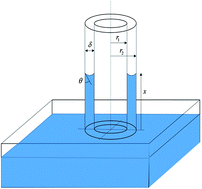Oscillatory regimes of capillary imbibition of viscoelastic fluids through concentric annulus
Abstract
In this study, we analyze the capillary filling dynamics of a viscoelastic fluid through a concentric annulus, which has far reaching consequences in practical applications and offers a distinct disparity in the dynamical characteristics as compared to the classical cylindrical capillary based paradigm. Such non-trivial characteristics are primarily attributed to a complex and intricate interplay between the intrinsic fluid rheology and the annular flow geometry, as is effectively manifested through distinctive features of the underlying oscillatory dynamics. We also estimate a criterion for the onset of oscillations, as a function of the Bond number. Our results predict remarkably attenuated oscillatory behavior and a higher capillary rise due to the presence of an annular geometry, as compared to a cylindrical one. We further relate the primary peak overshoot response with the Bond number that enables us to draw further physical insights into the oscillatory regime dynamics.


 Please wait while we load your content...
Please wait while we load your content...